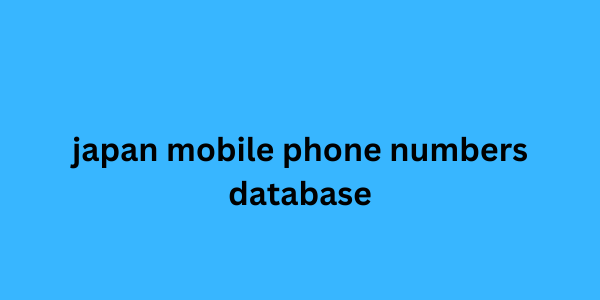We'll cover a lot of topics, all of them important. Let's go.
Content novelty
The first thing you need to do is find a balance between articles that are topical and long-lasting materials that will be relevant in a year or two.
Some people base their entire content strategy on newsjacking — news japan mobile phone numbers database interception, when you write an article on the heels of news, responding to the latest news. Read on Texterra how to work with this correctly . But don’t overdo it: newsjacking is good in moderation, and there are more pitfalls in it than it seems .
Another option is to rely on materials that will be returned to years later. A prime example is that same Texterra.
Another viable option is to write with reference to holidays, world film premieres, famous awards, seasons. For example?
If you sell flowers, create a series of popular articles about the right choice of bouquets, about color combinations, about the nuances of floristry, and tie them to you-know-what holidays. And if you specialize in diaries, then September 1st is a great excuse for articles about sketchbooks, about the nuances of time management, and simply about the history of diaries.
Make a calendar of the year's major events—and events that are important to your industry. And when you need some ideas, open the calendar and plan.
How to Write About Boring Companies
Last time we talked about how to write about plumbing. What could be more depressing? What could be more difficult? And it turned out that it was.
Banking, roofing, hydrology, payment aggregators, and the like. For some reason, it is believed that if the topic is not related to fashion or entertainment, then you won’t write anything about it. Or you will write, but no one will read it.
Complete nonsense.
There are no difficult topics. And no boring topics. You can write about everything in an exciting way. An example of this is Tinkoff Magazine , which writes exclusively about finances - but raises important and interesting topics: about commissions when paying by card abroad, how money is stolen through smartphones and what to do about it, or how to save on housing and communal services . Exemplary content marketing.
How to achieve the same? Put yourself in the reader's shoes. What would you like to know? There are plenty of people around who would be interested in the same things you are.
How to save and increase your pension savings?
What is the best way to secure cedar shingles?
Why is deep soil erosion dangerous and what is it anyway?
How safe is it to pay with a card on the Internet?
The topics are informative and interesting. And if you have already answered all possible questions from visitors, created a comprehensive FAQ and written materials that resolve all doubts and objections of clients - then it's time to move on to non-linear thinking. How exactly - we wrote in the first part.
Get a friend to brainstorm. Get a colleague. Get a stranger. And rack your brains together: what might be interesting to you and your audience?
Take a closer look at your readers. Start listening to the same music, watching the same movies, reading the same news. Visit the same forums, communicate in the same groups. Get into the shoes of your visitors. This way you will understand what to talk about. Share the nuances of the industry and be prepared for questions - not always smooth and even.
And then the questions will lead you to new ideas for content.
How to recognize the right idea
Okay, let's say we've sorted out the ideas. Here in front of you is a painted board, all in crooked mind map lines. Next to it is a thick folder with a bunch of photos and some quotes - your swipe file. A notebook is open in the middle - all covered in small handwriting. There are enough ideas, it seems, for years.

But how can you find the one from this mountain of ideas?
It's not that difficult. The procedure is simple:
Cross out everything you don't like.
Cross out anything that doesn't suit you for some reason - for example, it takes more time or money than you can afford. But don't rush to throw it out - just put it off until better times.
Write down the ideas that appeal to you. You don’t have to think about why you liked them now. Just make a list based on your intuition. Don’t dissect them! Your bright eyes will come in handy when you work on a project.
Take stock of what you've selected. Think about whether the idea is suitable for just one article? Or will it be suitable for a whole series?
Look for meaningful ideas with great educational potential.
Look at the resulting list of ideas. You see, there aren't that many suitable ideas. And if there's nothing left, then start looking again. Only this time, when you discuss and brainstorm, start from what didn't work last time.
Be helpful, work with pain
If you haven't yet taken your audience apart, it's time to do so. We wrote about this in Chapter 2 , wrote about it in the content strategy template , and we're writing about it now.
And now you have to deal with it.
